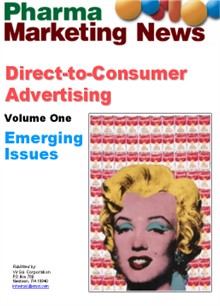On August 12, 1997 the FDA opened up the floodgates to DTC when it provided specific draft guidance for consumer-directed broadcast advertising. Since then, DTC has come a long way and you might say that the current period marks the "end of DTC as we have known it."
Changes in DTC advertising are evident to anyone who watches TV. Except for a few exceptions (eg, Botox: see, for example, "PhRMA Intern vs. BOTOX!"), there are no more 'reminder ads' on TV and ads have become more educational. Erectile dysfunction product ads, for example, actually talk about the medical conditions that may cause ED -- diabetes, high blood pressure, and high cholesterol. Imagine that!
TV ads also present side effect information more effectively. True, there may be an overuse of physicians or actors playing physicians. I’ve seen them in TV and print ads for Lipitor, Evista, Zetia, and Viagra to name just a few. Still, the benefit vs. risk dialogue is more balanced.
Back in June, 2005, I complained about print DTC ads that were creative with regard to presenting benefits but written in legalese mouse text when presenting the vital facts (see "Future of Drug Print Ads"). I suggested that drug companies prevent their lawyers from writing the so-called "brief summary" of the labeling, inclusion of which is required by FDA regulations.
Now we have Lipitor print ads with large type both front AND back! In fact, Pfizer’s new patient-friendly labeling information is almost as easy to read and understand as the as copy! Who could have imagined this?
Industry self-regulation -- specifically, PhRMA's Guiding Principles for Direct-to-Consumer Advertising -- has played a big role in bringing about these changes (see "PhRMA Finalizes DTC Principles"). However, these guidelines did not arise in a vacuum. Beginning with the withdrawal of Vioxx from the market by Merck in 2004, there has been a steady stream of criticism of pharmaceutical marketing practices from all corners, including traditional pharmaceutical industry supporters like Sen. Frist, former majority leader in the US Senate (see "Deconstructing Frist on DTC").
 These changes have been chronicled here in Pharma Marketing Blog as well as in my publication Pharma Marketing News. Now, I have collected together articles and commentary on this subject into a Special Supplement: Emerging Issues in DTC Advertising. At $29.95, it's a great deal and I hope you buy it.
These changes have been chronicled here in Pharma Marketing Blog as well as in my publication Pharma Marketing News. Now, I have collected together articles and commentary on this subject into a Special Supplement: Emerging Issues in DTC Advertising. At $29.95, it's a great deal and I hope you buy it. Go here for details and to buy by credit card online.
Description
This collection reviews in depth the issues and debates that have lead up to the industry's self-regulatory principles.
While we have come a long way and recent changes have changed the DTC landscape, there are still issues outstanding such as the communication of risk information. This collection, therefore, appropriately finishes on that note with the hope that further improvements are on the way.
Table of Contents
- Introduction: It's Been a Long Road! (pg. 1)
- Pharma Trends to Watch (pg. 2)
- To Ban or Not to Ban DTC, That is the Question (pg. 7)
- DTC Pros and Cons Presented at FDA Hearing (pg. 12)
- Marketing in the Post-Vioxx Era (pg. 19)
- Straight-Talking DTC (pg. 22)
- PhRMA Finalizes DTC Principles (pg. 24)
- Communicating Risk: Let the Dialog Begin (pg. 26)
- Merit of CHC Petition to FDA (pg. 33)
- Biotech DTC: Business Not As Usual (pg. 34)
- Print DTC: How Does It Measure Up? (pg. 37)

No comments:
Post a Comment